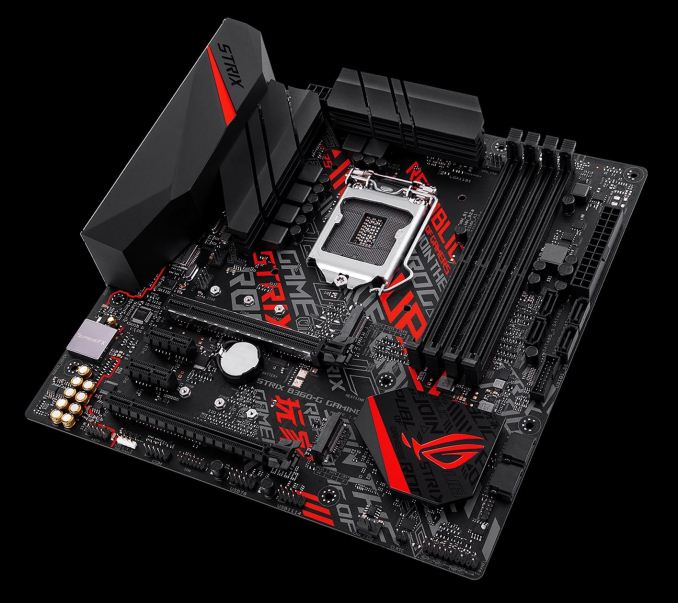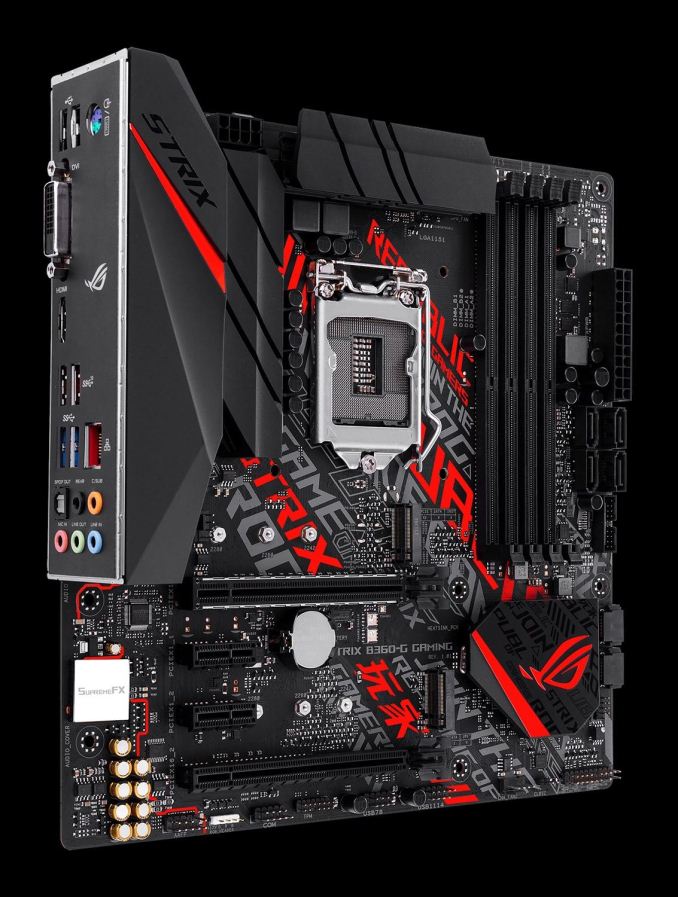The ASUS ROG Strix B360-G Gaming Review: A Polarizing $100 Motherboard Design
by Joe Shields on September 25, 2018 8:00 AM EST- Posted in
- Motherboards
- Intel
- Asus
- MicroATX
- CrossFire
- M.2
- Coffee Lake
- i7-8700K
- B360
Conclusion
The B360 chipset was designed to give users a more cost effective option for Coffee Lake based CPUs, in particularly processors which are locked and do not overclock. With this in mind, many B-series boards are cheaper but still include features like M.2 slots, USB 3.1 (10 Gbps) ports, and other features frequently found on most Z370 boards.
The ASUS B360-G Gaming offers users features that will rival most Z370 boards - this includes USB 3.1 (10 Gbps) ports, four DRAM slots, two M.2 ports, a reinforced PCIe slot, gaming-focused software, six SATA ports, robust VRM heatsinks, and costing less than a comparable board using the Z series chipset. It does have aesthetics that you really have to love, which could be a crucial part of how well this board performs in the market.
We saw already performance was solid throughout all testing on this board. In a change from other B360 boards we have reviewed, the ASUS B360-G Gaming did not throttle for any reason during testing which was good to see and allows the CPU to stretch its legs in testing without user input. The large heatsinks were able to handle the flagship i7-8700K at stock speeds without issue merely getting warm to the touch after extended heavy use and testing. The use of the SupremeFX S1220A codecs take the high-end Realtek ALC1220 codecs and improves upon them (at least on paper) with better SnR values whereas many B360 class boards tend to use a lesser Realtek codecs such as the ALC892 or ALC887. I also like the implementation of the integrated rear IO shield which gives the board a more premium feel.
As far as improvements needed from this board, there really isn't much needed or to complain about. Performance was spot on, and POST times were impressive. I suppose more USB ports couldn't hurt though. The biggest concern with the board is the look. That stenciling across the front with all the ROG sayings really doesn't tickle my fancy and can alienate some users looking for a fairly clean design aesthetic. As was mentioned earlier, the look can be pretty polarzing.
Overall, the ASUS B360-G Gaming MicroATX motherboard is a solid base to use any of the Coffee Lake processor it is compatible with. Performance values are right with the other board along with power use while boot times were quite fast under 17 seconds. Features wise, it includes most everything users come to expect from this class and size board, with an Intel networking port and higher-class audio. With the board priced around the $100 mark and no others with the same features priced with it, the B360-G Gaming stands as a good option in this space.
AnandTech 8th Gen CPU Coverage
- The Intel Core i7-8086K Review: Testing Intel's Anniversary 5.0 GHz Turbo CPU
- The Anandtech Coffee Lake Review: Initial Numbers on the Core i7-8700K and Core i5-8400
- Analyzing Z370 for Intel's 8th Generation Coffee Lake: A Quick Look at 50+ Motherboard












26 Comments
View All Comments
Threska - Tuesday, September 25, 2018 - link
Diagnostic displays come in handy when builds go south, or hardware dies. As for the mATX, I imagine much like houses, people are downsizing, so the computer doesn't eat the desk.Samus - Tuesday, September 25, 2018 - link
Yep. Throw it in a black case and move on. Who cares what the internals of a PC look like if you never see them.Holliday75 - Tuesday, September 25, 2018 - link
Yup thinking the same thing. If I was building a new Intel box right now I would probably purchase this board and never look at it again unless I was adding a drive or fixing something.Oxford Guy - Wednesday, September 26, 2018 - link
You do see them. Black-on-black is the bane of the computer installer's life. Board makers used to understand this and color-coded everything. Instead of ease-of-use, though, we have to be teenybopper edgelords these days. Skulls on SSDs coupled with Rainbow Brite LEDs.V900 - Thursday, September 27, 2018 - link
Oh you poor, naive fool!How will you communicate the fact that you like to game to people, with the case all locked up like that, hmm?
Didn't think about that, did you?
You know what people who come to visit you will think?
"That Samus guy is kinda cool, just too bad he's not a gamer!" Yup! Thats exactly what theyll think.
desolation0 - Friday, September 28, 2018 - link
If they don't get it from the original Unreal flyby benchmark test as screensaver I'm not sure they can be helped.willis936 - Tuesday, September 25, 2018 - link
In the DPC Latency section of the System Performance page:"Our DPC latency results for the B360-G Gaming 122 µs which is about par for the course after our minor script adjustments."
Compared to the last ryzen mobo review (asrock x470):
https://www.anandtech.com/show/12666/the-asrock-x4...
"While none of the manufacturers of the boards tested on the AM4 socket so far have been optimized for DPC latency,"
Am I to understand that sub 100 us is being considered "not optimized for DPC latency" while only two of the current list of coffee lake tested mobos approach 100 us are?
Is this an oversight or is there something I'm missing? It looks like the AM4 platform is currently ahead of coffee lake in terms of DPC latency.
Oxford Guy - Wednesday, September 26, 2018 - link
I wasn't sure what motherboard I could but that would let me play computer games. So, when I saw Gaming in the title I knew it was the board I needed.Oxford Guy - Wednesday, September 26, 2018 - link
I would like to suggest to these manufacturers, though, that they strongly consider putting a bleeding severed head on the plastic heatsinks, and prominently on the packaging also. Bleeding severed heads compliment SSDs with skulls on them and encourage people to think positively about the product.96redformula - Thursday, September 27, 2018 - link
I couldn't resist picking one up in my Mobo search a week ago a half ago at $90 shipped to the door. The text is non existent once it goes into a case, no big deal, but it sure did make me rethink it when I was purchasing it. The video card and aftermarket HSF cover it all just fine :)